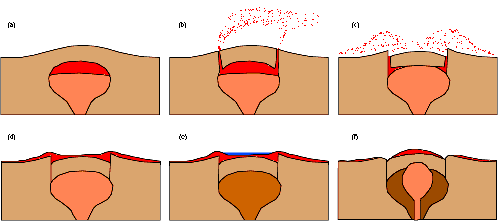|
COMETS EARTH JUPITER KUIPER BELT MARS MERCURY METEORITES NEPTUNE OORT CLOUD PLUTO SATURN SOLAR SYSTEM SPACE SUN URANUS VENUS ORDER PRINTS
PHOTO CATEGORIES SCIENCEVIEWS AMERICAN INDIAN AMPHIBIANS BIRDS BUGS FINE ART FOSSILS THE ISLANDS HISTORICAL PHOTOS MAMMALS OTHER PARKS PLANTS RELIGIOUS REPTILES SCIENCEVIEWS PRINTS
|
Related Document
Download Options
The evolution of a resurgent caldera begins when gas-rich magma collects near the roof of a magma chamber bulging under older volcanic rocks (a). After an eruption begins and collapse is initiated, ring shaped fractures propagate out of the chamber and burst to the surface, creating a vent for steam and gas. Decompressing gases and jets of pumice and ash follow at high speeds into the atmosphere (b). The upper part of the magma chamber froths, expands and flows up the vent. The velocity decreases as magma from the deeper parts of the chamber begin to flow out and the rocks overlying the magma begin to collapse along the fractures into the now emptied chamber (c). Pyroclastic flows continue as the initial burst of ash and deeper parts of magma flow across the surface covering the caldera and surrounding geographic area (d). The magma chamber is then depleted in gases and minor volcanic activity can persist along the ring fracture for as much as a million years. The crater is then mostly filled with volcanic ash and pumice and is quickly occupied by a crater lake (e). This flat-floored crater doesn't stay this way for long; the magma, now depleted in gases, continues to slowly rise. The crater floor is pushed up as much as 1 kilometer (.6 miles), forming a giant "blister." The caption is Copyright © by Rosanna L. Hamilton. The illustration is Copyright © by Calvin J. Hamilton. Any commercial/for-profit use needs to be addressed to Calvin J. Hamilton. |
||||||||||||||||||||||
